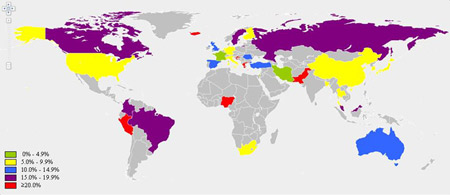IBS prevalence varied according to geography, diagnostic criteria
Prevalence of IBS varied according to a number of factors, including geographic location, diagnostic criteria for the illness, age and gender, according to a recent meta-analysis.
The study included data from 80 population-based cross-sectional studies on the prevalence of IBS in 260,960 participants aged 15 years and older.
“We wanted to systematically assess the worldwide prevalence and also highlight areas where future research is needed,” Alexander C. Ford, MD, senior lecturer and honorary consultant gastroenterologist at Leeds Gastroenterology Institute in Leeds, UK, told Healio.com. “Few studies have used the latest iterations of the Rome criteria [Rome III], and there has not been a cross-sectional survey reporting the prevalence of IBS in the UK for many years.”
Most studies were based in Southeast Asia (19 studies, 55,545 patients) and northern Europe (21 studies, 72,031 patients). Twenty-three studies incorporated the Manning criteria to define IBS, 24 used Rome I, 36 used Rome II and five used Rome III. Fifteen studies used more than one method on the same cohort.
The pooled prevalence for IBS was 11.2% (95% CI, 9.8%-12.8%) across all studies, with variation based on the location of study origin, with Southeast Asia having the smallest (7.0%, 95% CI, 5.0%-9.0%) and South America the largest (21.0%, 95% CI, 18.0%-25.0%).
Criteria used to define the condition also impacted prevalence for IBS, which was greatest in studies incorporating three or more of the Manning criteria (14.0%, 95% CI, 10.0%-17.0%) and smallest in studies using Rome I (8.8%, 95% CI, 6.8%-11.2%). Among 57 studies reporting duration of symptoms as a requirement for diagnosis, prevalence was greater in studies using 3 months (15 studies; 15.7%, 95% CI, 9.9%-22.7%) compared with those using 12 months (40 studies; 9.0%, 95% CI, 8.0%-11.0%).
In 55 studies reporting prevalence according to gender, IBS was more common in women than men (OR=1.67, 95% CI, 1.53-1.82). In 14 studies incorporating an age threshold of 50 years, patients aged 50 and older were less likely to have IBS than younger patients (OR=0.75, 95% CI, 0.62-0.92), and studies using 45 years as a threshold did not find significantly greater odds for IBS in older patients (OR=1.08, 95% CI, 0.85-1.39).
“Data concerning the effect of socioeconomic status on prevalence were sparse, and this should be addressed in future studies,” the researchers wrote. “In addition, more studies reporting the prevalence of IBS in the general populations of Central America, Africa, Australasia and South Asia are required.”

